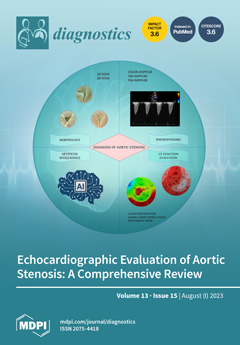This cross-sectional study aimed to compare optical coherence tomography angiography (OCT-A) findings in patients with primary Raynaud’s phenomenon (PRP;
n = 22), very early disease of systemic sclerosis (VEDOSS;
n = 19), and systemic sclerosis (SSc; 25 patients with limited cutaneous SSc (lcSSc)
[...] Read more.
This cross-sectional study aimed to compare optical coherence tomography angiography (OCT-A) findings in patients with primary Raynaud’s phenomenon (PRP;
n = 22), very early disease of systemic sclerosis (VEDOSS;
n = 19), and systemic sclerosis (SSc; 25 patients with limited cutaneous SSc (lcSSc) and 13 patients with diffuse cutaneous SSc (dcSSc)). Whole, parafoveal, and perifoveal superficial capillary plexus (SCP) vessel densities (VDs), deep capillary plexus VDs, and whole, inside, and peripapillary VDs were significantly higher in the PRP group (
p < 0.001). In the lcSSc group, the FAZ perimeter was significantly higher than that in the VEDOSS group (
p = 0.017). Retinal nerve fiber layer VDs were significantly lower in the lcSSc group than in the PRP and VEDOSS groups (
p < 0.001). The whole and peripapillary optic disc VDs of the VEDOSS group were significantly higher than in the lcSSc group (
p < 0.001). Whole SCP VDs (94.74% sensitivity, 100.00% specificity) and parafoveal SCP VDs (89.47% sensitivity, 100.00% specificity) showed the best performance in distinguishing patients with SSc from those with PRP. OCT-A seems to have potential diagnostic value in differentiating patients with PRP from patients with SSc and VEDOSS, and there is potential value in assessing prognostic roles, since findings from OCT-A images could be early indicators of retinal vascular injury long before overt SSc symptoms develop.
Full article






